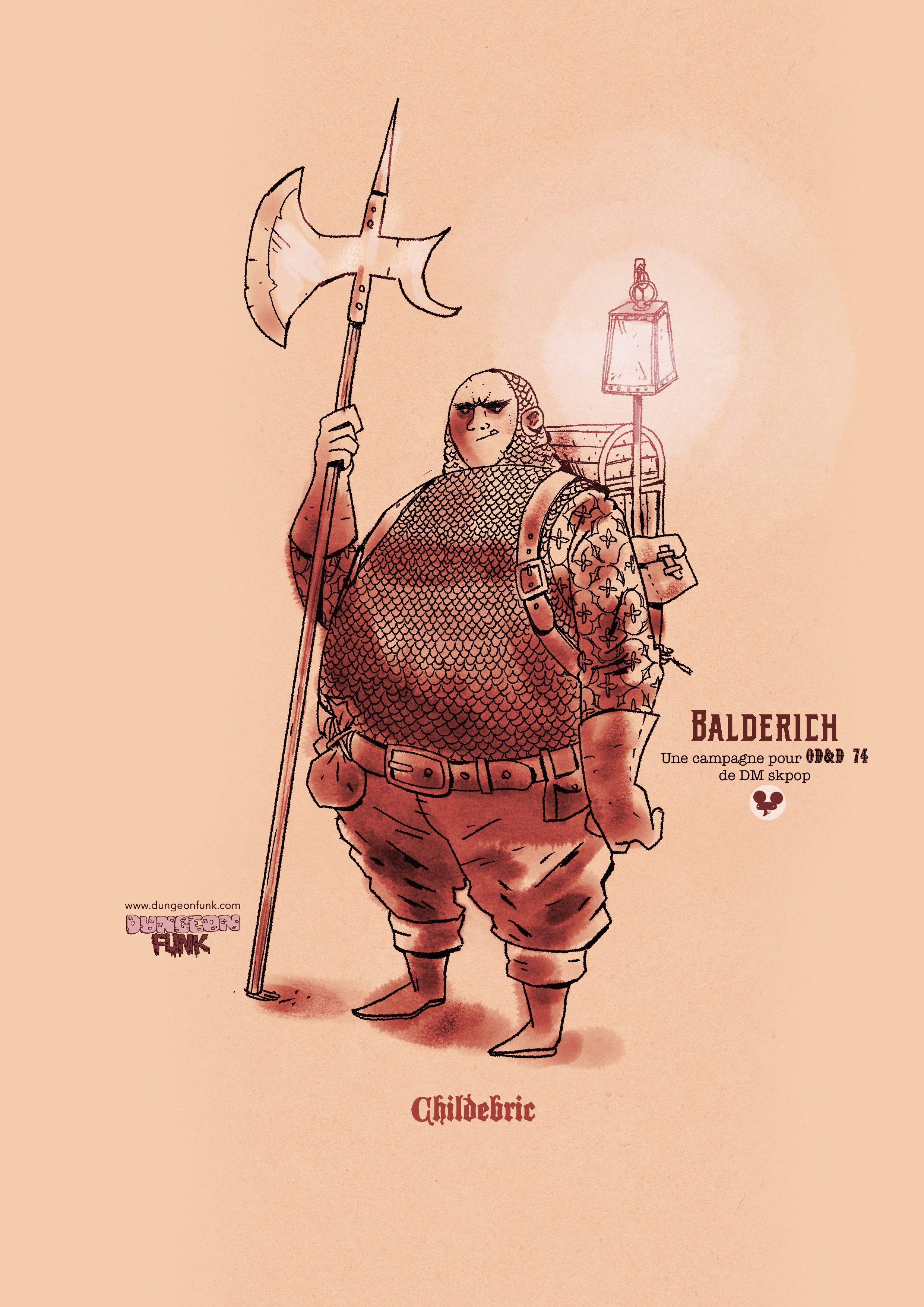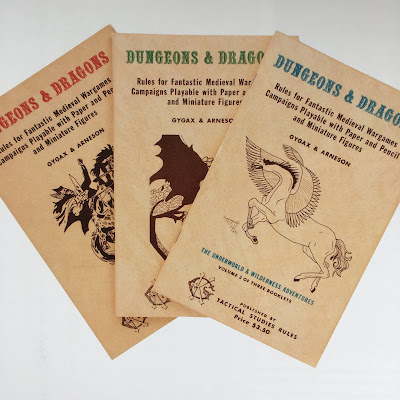Donc cette idée de résumer les règles d'OD&D finit par prendre bien plus de temps qu'escompté. Je pense que j'ai commencé vers 2008 et que ça m'a pris deux ou trois ans pour arriver à une version des règles satisfaisantes au niveau du contenu et de la présentation. Au final, je me suis retrouvé avec trois livrets de 64 pages.
So this "let's summarize OD&D rules" project took waaaaay longer than I expected. I think it started around 2008 and it took me a couple of years to come up with a version of the rules I was satisfied with, both in terms of content and presentation. I ended up with three digest-sized 64-pages books.
Voilà à quoi ont fini par ressembler les "trois petits livres" d'OD&D.
This is how the "three little books" ended up looking. I redesigned the knight, the dragon and the hippogriff from the original covers (see previous blog post). The white background is reminiscent of OD&D "white box" and the type evokes the old-school DIY esthetic of the early editions.
Vu que j'avais surtout l'habitude du système Chaosium, j'ai mis du temps à comprendre (ou à accepter) certains aspect du système D&D. J'ai commencé à lire des blogs de la nébuleuse OSR et j'y ai trouvé des trésors de ressources que j'ai incorporés dans mon propre livre de règles, qui finit par devenir un mélange du D&D original d'Arneson et Gygax, de règles alternatives, de tables et de commentaires issus de la blogosphère. Je n'ai rien écrit moi-même, me contentant de jouer le rôle de l'éditeur.
Coming mostly from a Chaosium background, it took me a while to wrap my head around some aspects of the D&D system. I started reading ORS blogs for help and found a wealth of material which I started to absorb into my own rulebook. Basically the books became a mix of Original D&D rules by Arneson and Gygax, alternative rules, tables and commentaries by various OSR bloggers. I didn't write anything myself, strictly playing to role of an editor.
Le premier livre traite de la création de persos, du combat, des mécaniques de bases comme les jets de caractéristiques et autres tests et de la magie.
The first book, "Men & Magic", covers character creation, combat, basic mechanics like ability rolls and other checks and, of course, magic.
En tant qu'éditeur de ma propre version privée, j'ai eu le plaisir d'"embaucher" des artistes sans leur consentement pour réaliser les illustrations intérieures.
A great joy as the editor of my own private version was being able to "hire" unsuspecting artists to provide the interior art. Case in point, this (unrelated to D&D) illustration seemed like a perfect illustration of Vancian magic.
Le deuxième volume traite des monstres et des trésors.
The second volume is "Monsters & Treasure". Pretty self-explanatory.

J'ai pu utiliser les représentations des monstres de mon exemplaire de la première édition de Warhammer Fantasy Roleplay sans devoir me soucier des problèmes de propriété intellectuelle!
I was able to use monster depictions from my copy of Warhammer Fantasy Roleplay (First edition) without any intellectual property issues!
Une illustration classique de David Trampier orne le chapitre sur les trésors.
A classic David A. Trampier illustration graces the "Treasure" section.
Le troisième livre comprend des conseils pour les MD sur comment mener des aventures sur ou sous la surface terrestre.
The third book, "The Underworld & Wilderness Adventures", includes advice for DMs on how to run a both "dungeoncrawl" and "hexcrawl" adventures.
Un plan de coupe de Skull Mountain (extrait de l'édition dite de la "boîte bleue" supervisée par J. Eric Holmes)
Skull Mountain cross-section (originally from the "blue box" Holmes edition).
Des conseils sur les mégadonjons par Al Krombach (qui tenait le blog "Beyond The Black Gate").
Advice on Megadungeon design by blogger Al Krombach ("Beyond The Black Gate").
Cet article de Philotomy Jurament (Jason Cone) était, et reste toujours, une introduction efficace au style de jeu originel.
This essay by Philotomy Jurament (Jason Cone) was, and still is, a powerful introduction into old-style play.
J'adore les livres et j'adore fabriquer des livres. Le travail d'édition et de mise en page sur "The Annotated Dungeons & Dragons" m'a pris beaucoup de temps. J'étais absorbé par cette tâche, par le design du jeu (autant fonctionnel qu'esthétique) et j'ai beaucoup appris sur les racines du hobby. Est-ce que c'était nécessaire? Probablement pas. Est-ce que j'aurais dû simplement jouer à n'importe quelle édition? Peut-être. Est-ce que j'utilise ces livres dans mes parties à l'heure actuelle? Pas vraiment. J'utilise une réduction supplémentaire qui tient sur huit pages, Manuel des Monstres compris. Mais pour arriver à ce point, je crois que je devais d'abord digérer les règles d'OD&D et, pour ce faire, il me fallait les arranger d'une manière qui me paraisse claire et plaisante.
I love books and I love creating books. Designing and editing "The Annotated Dungeons & Dragons" took a long time. It was an absorbing task. I was immersed in game desgn and game art and I learned a lot about the roots of the hobby. Now, was all this necessary? Probably not. Should I have been playing whatever ruleset instead? Maybe. Am I using these books when I play nowadays? Not really. I'm using a further distillation that holds on eight pages, Monster Manual included. But to get to that point, I believe I had to process OD&D rules first, and arranging them in a way that I found clear and appealing was a necessary step in that process.













































